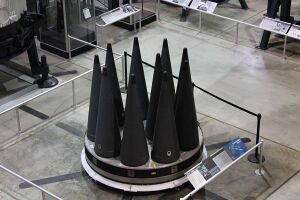Multiple independently targetable reentry vehicle
(missile) | |
|---|---|
 | |
A multiple independently targetable reentry vehicle (MIRV) is an exoatmospheric ballistic missile payload containing several warheads, each capable of being aimed to hit a different target. The concept is almost invariably associated with intercontinental ballistic missiles carrying thermonuclear warheads, even if not strictly being limited to them. An intermediate case is the multiple reentry vehicle (MRV) missile which carries several warheads which are dispersed but not individually aimed. All nuclear-weapon states except Pakistan and North Korea are currently confirmed to have deployed MIRV missile systems. Israel is suspected to possess or be in the process of developing MIRVs.[2]
The first true MIRV design was the Minuteman III, first successfully tested in 1968 and introduced into actual use in 1970. The Minuteman III held three smaller W62 warheads, with yields of about 170 kilotons of TNT (710 TJ) each in place of the single 1.2 megatons of TNT (5.0 PJ) W56 used on the Minuteman II. From 1970 to 1975, the United States would remove approximately 550 earlier versions of the Minuteman ICBM in the Strategic Air Command's (SAC) arsenal and replace them with the new Minuteman IIIs outfitted with a MIRV payload, increasing their overall effectiveness. The smaller power of the warheads used (W62, W78 and W87) was offset by increasing the accuracy of the system, allowing it to attack the same hard targets as the larger, less accurate, W56. The MMIII was introduced specifically to address the Soviet construction of an anti-ballistic missile (ABM) system around Moscow; MIRV allowed the US to overwhelm any conceivable ABM system without increasing the size of their own missile fleet. The Soviets responded by adding MIRV to their R-36 design, first with three warheads in 1975, and eventually up to ten in later versions. While the United States phased out the use of MIRVs in ICBMs in 2014 to comply with New START, Russia continued to develop new ICBM designs using the technology.[3]
The introduction of MIRV led to a major change in the strategic balance. Previously, with one warhead per missile, it was conceivable that one could build a defence that used missiles to attack individual warheads. Any increase in missile fleet by the enemy could be countered by a similar increase in interceptors. With MIRV, a single new enemy missile meant that multiple interceptors would have to be built, meaning that it was much less expensive to increase the attack than the defence. This cost-exchange ratio was so heavily biased towards the attacker that the concept of Mutually Assured Destruction became the leading concept in strategic planning and ABM systems were severely limited in the 1972 Anti-Ballistic Missile Treaty in order to avoid a massive arms race.
In June 2017, the United States finished converting its Minuteman III missiles back to using a single reentry vehicle system, as part of its obligations under the New START treaty.
References
- ↑ "Each of the ten MK-21 cones held a nuclear weapon and was covered with a heat shield to protect it during re-entry into the atmosphere"
- ↑ "Multiple Independently Targetable Reentry Vehicles (MIRVs)"
- ↑ "Putin has touted an 'invincible' nuclear weapon that really exists — here's how it works and why it deeply worries experts"
Wikipedia is not affiliated with Wikispooks. Original page source here